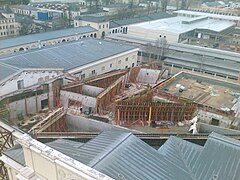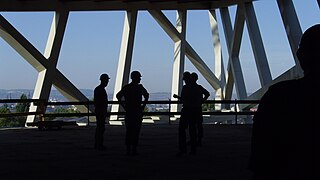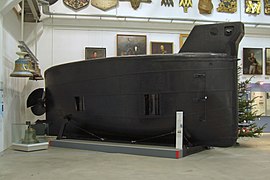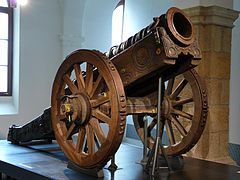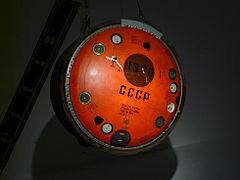Military history museum of the Bundeswehr

|
|
| Data | |
|---|---|
| place | Dresden , Germany |
| Art |
History museum , military museum
|
| architect | Daniel Libeskind (new building) |
| opening | 1961 as the German Army Museum in Potsdam. 1972 Relocation to Dresden and renaming to the Army Museum of the GDR. 1990 Takeover by the Bundeswehr and renaming to the Military History Museum. 2010 Closure of the exhibition. October 14, 2011 new opening. |
| Number of visitors (annually) | around 500,000 visitors in the first year after reopening |
| management |
Colonel Armin Wagner (since 2017)
|
| Website | |
| ISIL | DE-MUS-844919 |
The Military History Museum of the Federal Armed Forces (MHM) in Dresden (formerly Military History Museum Dresden ) is one of the largest military history museums in Europe and, alongside the House of History in Bonn , the Germanic National Museum in Nuremberg and the German Historical Museum in Berlin, one of the four major history museums in Germany . The MHM includes the Military History Museum Airfield Berlin-Gatow (formerly the Air Force Museum of the Bundeswehr ) and exhibitions in the armories at Königstein Fortress . On October 14, 2011, the museum reopened after extensive renovations planned by the architect Daniel Libeskind . In 1994 it was expanded to become the leading museum in the Bundeswehr Museum and Collection Association.
history
The building on Olbrichtplatz was built from 1873 to 1877 as the main Arsenal building and formed the center of Albertstadt . The guns of the Königl. Saxon army formation, the upper floors served as a depot for handguns and edged weapons . When the arsenal was inaugurated on May 1, 1877, the old Dresden armory on Brühl's terrace was abandoned and converted into the Albertinum . Since 1897 the building housed the Royal Arsenal Collection and later the Royal Saxon Army Museum. After the First World War it was abandoned as a military depot. The farm buildings were rented to various companies, the main building remained as a storage place for military equipment. In 1923/24 the building was once again turned into a museum as the Saxon Army Museum. In 1938 the museum was renamed the Army Museum of the Wehrmacht and in 1942 the Army Museum and was open until 1945.
After the end of the war , the Red Army confiscated the stocks and had most of them transported to the Soviet Union. The Army Museum was then closed. The building was taken over by the city of Dresden and, as the north hall, was the venue for exhibitions of the city museum and other events, including the Dresden Striezelmarkt, until 1967 . The first exhibition on Dresden's reconstruction also took place in the north hall.
On March 24, 1972, the German Army Museum, which opened in the Potsdam Marble Palace in 1961, moved into the former arsenal building. The focus of the exhibition center, now known as the Army Museum of the GDR , was the history of the National People's Army and its allies in the Warsaw Pact on an exhibition area of 8,000 square meters (7,000 square meters covered, 1,000 square meters open space). After returning part of the holdings of the former Saxon Army Museum, these could also be shown. The GDR military library was located in the same building.
In 1990 the Federal Ministry of Defense took over the museum under the name of the Military History Museum. In 1994, the then Federal Defense Minister Volker Rühe decided to expand the new location into the Central Museum of the Bundeswehr. Nevertheless, the permanent exhibition was still shaped by the GDR flair with class struggle and East-West conflict until 2003 .
In 2001 the building was put out to tender for redesign. The American Daniel Libeskind won the architectural competition . After seven years of renovation, the museum reopened on October 14, 2011.
As in other Bundeswehr agencies, reservists regularly work in the Military History Museum . For example, the politician and historian Peter Tauber and the Mayor of Delitzsch and museologist Manfred Wilde have already worked on projects as part of reservist services .
modification
The museum was rebuilt according to plans by Daniel Libeskind, HG Merz and Holzer Kobler Architekturen . The completion, originally planned for 2008, was delayed until autumn 2011. The cause was the installation of security technology and a restaurant, which increased the costs from 35 to 62.5 million euros initially. During the new construction and renovation work, a selection of exhibits was presented in an interim exhibition in an adjoining building until September 2010. The new permanent exhibition was opened on October 15, 2011.
According to the deconstructivist design, the historic building was supplemented with a wedge-shaped installation and split. As a result, a third of the structure of the arsenal was lost. During the air raids on Dresden in February 1945, the bomber formations of the British Royal Air Force (RAF) had approached Dresden's old town in the form of a wedge. The tip of the wedge points to the Heinz-Steyer-Stadion (then the stadium at Ostragehege ), northwest of the city center , where the RAF scout units set target markers for the heavy Avro Lancaster bombers during the attack . However, the V-shaped wedge not only symbolically shows the bombing of Dresden, but also illustrates the new conception of the exhibition. The traditional, the chronological exhibition in the historic arsenal building, is broken through by the modern wedge, which includes a special themed course in which topics spanning various epochs are dealt with. The building blocks of a cultural history of violence were brought together. The design of the permanent exhibition was carried out by the museum designers Hans-Günter Merz and Holzer Kobler Architekturen.
Task and mission
The MHM is a specialist museum with international standards for the presentation of military history and military-technical developments in the German-speaking area. As an institution of the Bundeswehr , the MHM is given the objective of making a museum contribution within the framework of training and further education in the fields of historical and political education as well as in the field of military technology .
In this function it fulfills its task primarily through the collection, the scientific processing, the preservation and the development of permanent and special exhibitions on military-historical topics. In terms of service, it is subordinate to the Center for Military History and Social Sciences of the Bundeswehr (ZMSBw) in Potsdam , which in turn reports to the Center for Inner Leadership .
Museum guiding principle
The museum does not see itself primarily as a technical history museum, but as a cultural history museum. It aims to provide information about history, stimulate questions and offer various answers. It should strive for a critical discussion without pathos.
Analogous to the aim of general historical studies, the museum places people at the center of its permanent exhibition, since only human nature makes the causes of war understandable. The museum shows the building blocks of a cultural history of violence, the nature and cause of which permeates all exhibition areas as well as the structural conception. In the sense of a modern military-historical approach, the military is understood not only as an institution, but as a factor of economic, social, cultural and public life. The overall conception of the architecture and the new permanent exhibition represents the juxtaposition of classic and novel perspectives and forms of expression. Tradition and innovation - old and new interpretations of military history - form the cornerstones of the concept. The MHM offers two approaches to military history, which are architecturally and thematic cross-sections in the new building and a chronological tour in the renovated old building.
In the new building, exhibits are placed in larger contexts of meaning, experience and function according to overarching topics. This part of the museum is devoted to the synopsis and comparability of similar, identical and related phenomena, processes and memories that cannot be assigned to just one epoch. The exhibition design can thus create a critical distance from the exhibits and thus counteract any technical fascination.
The chronological part leads from the late Middle Ages to the present day. The relationship between the military and society in Germany is presented against the background of general history. Overarching central questions run through the chronology and allow a different view of old objects and topics. The different levels of knowledge and experience of the visitors are taken into account by means of a three-part room system. The outdoor course juxtaposes equipment from the National People's Army and the Bundeswehr from the Cold War era, but also shows modern weapon systems.
In 2013 there were 10,000 exhibits in the permanent exhibition; over a million objects are stored in the depot.
Special exhibits and special exhibitions (selection)
- The fire diver reconstructed from fragments of the first German submarine , which was originally built by August Howaldt in Kiel in 1850 according to plans by Wilhelm Bauer . From November 13th, 2007 to January 6th, 2008 the museum showed the special exhibition "100 Years of German Submarines"
- The Soyuz 29 landing capsule , with which the first German in space Sigmund Jähn came back to earth after his Soyuz 31 flight , is one of the collections. The capsule is back in the house after being loaned to the German Museum in Munich for several years .
- The inland minesweeper Atlantis of the German Navy, put into service in 1968 . Since April 2000 it has been a museum ship 5 km from the museum in the Alberthafen Dresden .
Fire divers in front of the museum redesign
P-51 - support surface , V-2 -Triebwerk and searchlights 36
Soyuz-29 landing capsule
In 2019, on the occasion of the 75th anniversary of the assassination attempt on Adolf Hitler prepared by Claus Schenk Graf von Stauffenberg , a special show is being prepared. The museum director Armin Wagner said: “The women and men of July 20 [1944] still occupy a prominent place in the Bundeswehr's understanding of tradition. Our special exhibition on the subject will therefore shed light on the background and the people involved. ”The opening is planned for July 4, 2019.
- The Canaletto painting Der Zwingergraben in Dresden was part of the museum's permanent exhibition before it was restituted in 2019.
Museum director
Army Museum of the GDR
| Period | Surname | Rank | photo | Whereabouts |
|---|---|---|---|---|
| 1972 to December 1, 1981 | Johannes Streubel | Rear admiral | then retirement | |
| 1981 to 1989 | Alfred Nikolaus | Colonel | ||
| 1989 to 1990 | Wilfried Zumpe | Colonel | then retirement |
Directors of the Military History Museum of the Bundeswehr
| Period | Surname | Rank | photo | Whereabouts |
|---|---|---|---|---|
| October 1, 1990 to April 11, 1991 | Manfred Kunz | Lieutenant colonel | Head of Museum Education until 2007, then retired. | |
| April 12, 1991 to September 18, 1994 | Hans-Jürgen Heibei | Frigate captain | ||
| September 19, 1994 to September 30, 1998 | Christian-Wilhelm von Prittwitz and Gaffron | Lieutenant colonel | ||
| October 1, 1998 to 2003 | Thomas Eugen Scheerer | Frigate captain | Command academy of the Bundeswehr | |
| 2003 to December 13, 2006 | Franz-Josef Heuser | Lieutenant colonel | retirement | |
| December 14, 2006 to June 27, 2010 | Ferdinand Freiherr v. Richthofen | Lieutenant colonel |  |
|
| June 28, 2010 to March 15, 2017 | Matthias Rogg | Colonel |  |
Command academy of the Bundeswehr |
| since March 16, 2017 | Armin Wagner | Colonel |
Scientific director of the museum
From 2004, scientists were appointed to design the permanent exhibition and as lecturers. That was the historian Siegfried Müller for the years 2004/2005 and Gorch Pieken (from 2006 to 2017).
Awards
- On April 17, 2013, the museum was awarded the Sprinkler Protected seal of approval from the Federal Association of Technical Fire Protection . The fire extinguishing system consists of over 3000 sprinkler heads and 13 kilometers of pipeline. The cost was 1.3 million euros.
- On April 27, 2013 the museum received the Luigi Micheletti Award from the European Museum Academy. The award recognizes innovative creative presentations.
See also
Web links
- Internet presence of the Military History Museum of the Bundeswehr
- For the reconstruction of the museum by Libeskind , on das-neue-dresden.de
- Libeskind's concrete wedge through the MHM in Dresden , on baulinks.de
- Alexandra Kaiser: People always die. The Military History Museum of the Bundeswehr opens in Dresden with a new concept , on zeitgeschichte-online.de
- Museum check with Markus Brock : Military History Museum of the Bundeswehr in Dresden. Synopsis and video from 3sat . First broadcast: July 20, 2014
- Catalog. Army Museum of the German Democratic Republic 1917–1945. The German working class in the fight against counterrevolution, reaction and fascism. Historical objects from the Army Museum of the German Democratic Republic. Army Museum of the GDR, Dresden 1975
- Video "Through the Military History Museum Dresden - in 360 °" on YouTube
literature
- Gorch Pieken , Matthias Rogg (Ed.): The Military History Museum of the Bundeswehr. Exhibition guide. Sandstein Verlag, Dresden 2011, ISBN 978-3-942422-69-7 .
- Gorch Pieken, Matthias Rogg (ed.): Military history museum of the Bundeswehr. Exhibition and architecture. Sandstein Verlag, Dresden 2011, ISBN 978-3-942422-51-2 .
- Gorch Pieken: Contents and Space: New Concept and New Building of the Militarhistorisches Museum of the Bundeswehr . In: Wolfgang Muchitsch (Ed.): Does War Belong in Museums? The Representation of Violence in Exhibitions (= Edition Museumsakademie Joanneum . Vol. 4). Transcript, Bielefeld 2013, ISBN 978-3-8376-2306-2 , p. 63 ff.
Individual evidence
- ↑ Swen Steinberg: Review of: Military History Museum of the Bundeswehr, Dresden. In: H-Soz-Kult . January 14, 2012, accessed March 4, 2020 .
- ^ Pieken, Gorch: Reopening of the Military History Museum of the Bundeswehr in Dresden . In: Sächsische Heimatblätter . No. 57 . Saxon Printing and Publishing House, Dresden 2011, p. 326 .
- ^ Pieken, Gorch: New conception and new building of the Military History Museum of the Bundeswehr in Dresden . In: Saxon State Office for Museums; State Office for Non-State Museums in Bavaria; Asociace muzeí a galerií České republiky (ed.): Military history in the museum: 15th International Conference of Bavarian, Bohemian and Saxon Museum Experts, October 15-17 , 2006 . No. 15 . Saxon State Office for Museums, Chemnitz 2008, p. 36 .
- ↑ Herbert Wotte, Siegfried Hoyer: City Guide Atlas Dresden . 1st edition. VEB Tourist Verlag, Berlin / Leipzig 1978, p. 82 .
- ↑ PA_FOC: Peter Tauber: "General" as first lieutenant. In: Focus Online . August 13, 2016, accessed October 14, 2018 .
- ↑ https://www.facebook.com/MHM.Dresden/photos/a.621055131280088.1073741829.220212508031021/808475715871361/?type=3&theater
- ^ Military History Museum of the Bundeswehr , accessed on May 26, 2014
- ↑ Military History Museum of the Bundeswehr , accessed on February 7, 2013
- ↑ David Nissen: More valuable than money . In: Sächsische Zeitung May 2, 2013, online for a fee , accessed on May 2, 2013
- ↑ Atlantis minesweeper
- ↑ Pictures of the Atlantis in Alberthafen ( Memento from June 30, 2013 in the web archive archive.today )
- ^ Museum is planning a special show on Stauffenberg . In: Berliner Zeitung , January 7, 2019, p. 22.
- ↑ Inventory overview of the Federal Archives, 4.1.1.3.1 Political Headquarters / Central Politorgane, DVP 3-4 Army Museum of the GDR ( Memento of the original from November 4, 2013 in the Internet Archive ) Info: The archive link was inserted automatically and has not yet been checked. Please check the original and archive link according to the instructions and then remove this notice.
- ↑ The Sprinkler Protected Award goes to ... the Military History Museum of the Bundeswehr in Dresden , press release on bvfa.de, accessed on April 9, 2013
- ↑ Franziska Schneider: In the museum, prizes are being deleted , in: Sächsische Zeitung April 9, 2013, online for a fee , accessed on April 9, 2013
- ^ Military History Museum wins Micheletti Prize , in: Sächsische Zeitung April 29, 2013, accessed on April 29, 2013
Coordinates: 51 ° 4 ′ 42.4 " N , 13 ° 45 ′ 35.9" E


